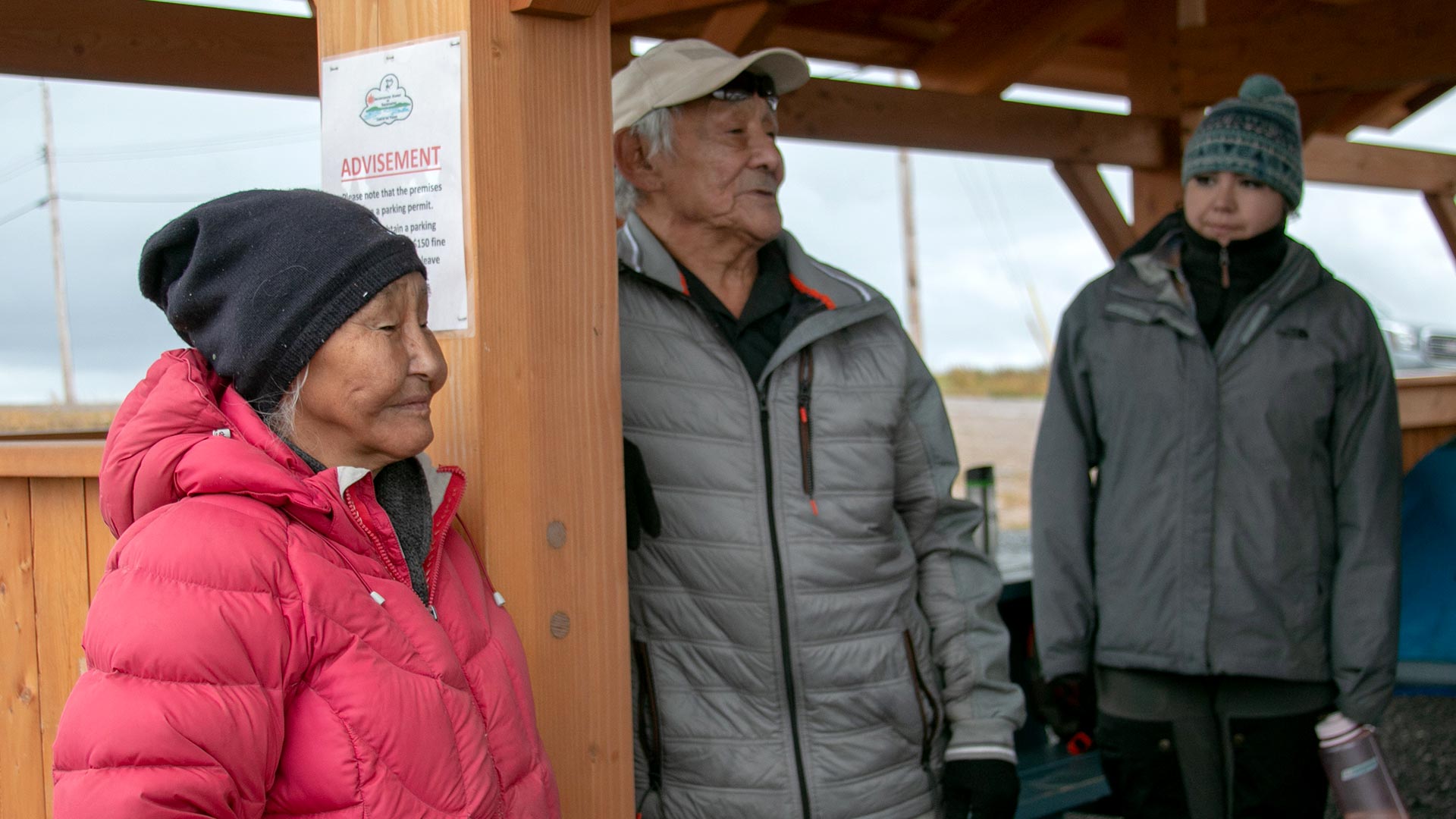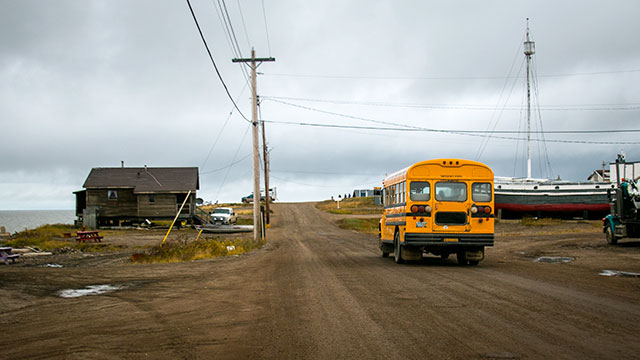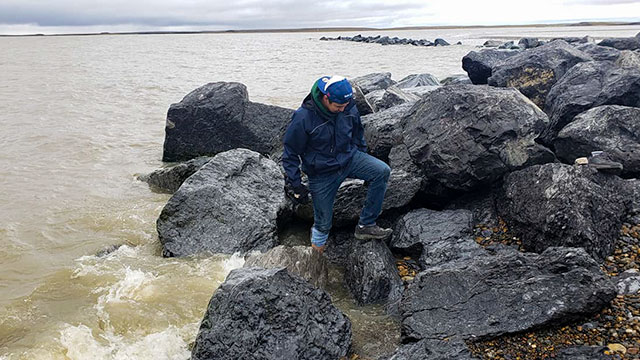Hannah Taneton sleepily grabs gloves and a toque and emerges from her tent to be greeted by howling winds and cold rain.
It’s two degrees in August, a month once known for ideal temperatures in Tuktoyaktuk, also known as Tuk, Northwest Territories – an Inuvialuit hamlet of roughly 850 people on the shore of the Beaufort Sea.
According to scientists, altered weather patterns from climate change are bringing stronger and more frequent storms here.
But the bleak forecast won’t put a damper on Taneton’s spirit. She’s come here to learn about the shifts in the environment.
“Speak to your neighbours or even people further out to see if they are having the same problems or different from your area,” Taneton says.
Like all of the youth attending the climate change summit, each have felt the effects of global warming in their communities.
But destruction this far north is like nothing they have ever known.
So far the students have learned from researchers, but now they will take their cues from Elders who have been the eyes and ears for southern scientists investigating northern realities.
Elder’s knowledge
As soon as Roy and Julia Cockney step into the rental SUV, youth bombard them with questions.
Everything from what type of fish they’re catching to whether they can travel far on the sea ice.
“For the last two years we have gotten char (arctic char) and salmon. When I look at the fish and open them up there are a lot of eggs. I think, what is going to happen is if they find a place to spawn? Tuk one day might be all salmon,” Roy says, answering to the youth’s enthusiastic curiosity.
The Cockney’s are well-respected Inuvialuit Elders who have lived in Tuk their whole lives and bring the youth out to The Point, an area close to their old fish camp on the north end of the hamlet.
No swimming signs are posted along the once frequented look out area at the point. The coast is so filled with sediment that it acts as quick sand and Elders say fish no longer spawn there because of it.
As sea ice melts, there are longer periods of open water which lead to bigger waves, thawing permafrost and ultimately rapid coastal erosion.
(Tuktoyuktuk is an Inuvialuit hamlet of roughly 850 people on the shore of the Beaufort Sea. Photo: Charlotte Morritt-Jacobs/APTN)
Since 2018, you can no longer swim at The Point because of high waves and sinking sediment make for unsafe conditions.
“In the summer time the ocean used to be calm and glassy, but this past month of July was rough. There’s no room to put a tent on the beach anymore,” says Julia Cockney. “I sat on Tuk council 10 years ago, the hamlet saw what was coming 30-40 years ago.
“They figured they would move Tuk to Reindeer point [an abandoned Inuvialuit settlement nearby], but it is just this year they are beginning to move houses.”

Roy has been fishing for the last 40 years.
He proudly shares how the family tradition was passed on from his dad who had a fish camp across the bay.
“We had a house for a fishing camp, but the erosion got so bad that it caved in and we had to move the house upland. It’s gotten even worse in the last 5-7 years,” Roy says.
“The winds from the west are really bad but in the last few years eastern winds are picking up to.”
Elders who have relied on their traditional knowledge to predict the weather and climate, have witnessed a change in cloud and wind patterns.
Unpredictable forecasts have made it difficult to go on-the-land for country foods.
While the youth ask many questions with ease during the summit, they admit discussing climate change back home has its challenges.
“Elders today, they always grew up knowing their language. For us not to understand them… if I were to ask them a question in English they would like to hear it in their language, to get a better understanding,” said Taneton, a youth from Délįne NWT.
Taneton says she doesn’t fluently speak her Sahtúot’ı̨nę Yatı̨́ Dene language, and has to be mindful when communicating with elders about climate change.
(Tourism to Tuk has increased since the highway from Inuvik opened in 2017. Photo: Charlotte Morritt-Jacobs/APTN)
Canada’s Arctic land mass represents 40 per cent of the country – nearly half of the far north’s coastline.
But less than a quarter of Canadians live here.
Tourism to the north is the rise since the opening of the Inuvik to Tuktoyaktuk Highway in Nov. 2017.
It’s the first all-season road to reach Canada’s polar shores and camp grounds are beginning to pop up to accommodate travelers flocking from all over the world.
Deterioration of unique Arctic environments and heritage sites that garner tourism dollars is what Roy and Julia fear.
The Cockneys are proud of their roots and want to show them off while they still can, so they accompany the students on a tour of a traditional mud house and teaching Inuvialuit games like Nabahik.
It’s further example of the deep rich culture for northern Indigenous people that’s at risk of being lost with coastal erosion.
And it rubs off on youth like Anonda Canadian from Zhahti Koe, NWT.
“I don’t see it like this back home because I am more in the middle of the continent, not like Tuktoyaktuk,” says Canadian. “That just broke my heart because if the way it keeps going, Tuktoyaktuk will be under water soon.
“They have had seven storms already and it isn’t even storm season.”
But the summit is not intended to solely focus on the physical and cultural experienced by northerners.
It’s also meant to shift attitudes and inform delegates like Ethan Eyakfwo, a youth from Gamètì, NWT.
(Ethan Eyawkfwo braves the slippery rocks placed along the shore by the Tuk hamlet in an effort to slow coastal erosion. Photo by Charlotte Morritt-Jacobs/APTN)
“Before this conference I didn’t feel strong emotionally. When we spoke with Roy and Julia and others in the community it hit harder,” he says. “When I think about climate change I thought about how it only effected my region, my people.
“You can tell these Elders are scared not for themselves but future generations,” says Ethan Eyakfwo.
No matter what barriers youth face in their pursuit of understanding and adapting to climate change, Roy and Julia urge participants to keep fighting.
And the first step for the youth to learn is to listen to their Elders.
“For me when we learn about how to live our lifestyle in the bush. Our elders say we have to start them off young, for climate change I think it is the same philosophy,” says Eyakfwo.
“We have to start off young and carry that torch as we get older. We can pass that torch to another generation for them to learn, guiding them and teaching them about climate change.”












